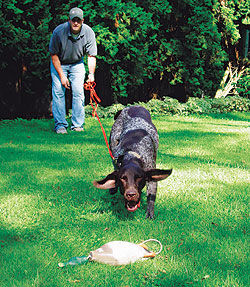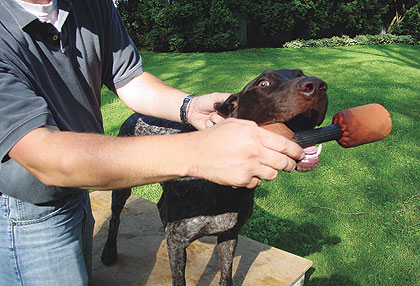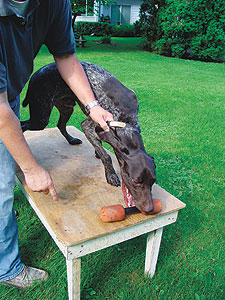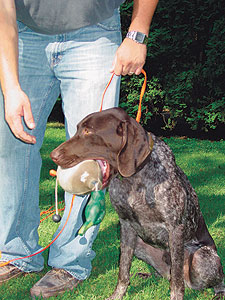After Hold, Carry And Release, Next Comes The Pick-Up
By Bob West
 Another transition point occurs when you begin sending the dog to pick up the dummy at some distance. A key point to note: throughout training, as Tim does here, always use a lead or check-rope to be sure you are able to make corrections if needed. |
It has been proven that dogs progress best when trained using easily accomplished steps. At each plateau there is sort of a "mental safe place" that builds confidence and a basis for the next step. Coupled with avoidance training this concept goes to the heart of complex scenarios and yields a self-confident, stylish and obedient dog.
In the previous issue we outlined the steps needed to bring our dog to understand and obey a command to hold and to carry a dowel or training dummy as the basis for the trained retrieve. If you haven't read that article, please do so, as it's fundamental to the following.
Assuming you've followed those steps, your dog now understands and obeys FETCH€¦he understands the command means he is to hold and carry a training dummy, to walk, run, jump, whatever, and not drop or spit it out, until a release command is given. We also hope your dog is even beginning to open his mouth and reach for the dummy...in fact, that's our next goal.
Let's go back to the training table. The next step in our program is having the dog open his own mouth to accept and hold the dummy. Up to this point we've opened the dog's mouth and put the dummy in.


To view "The Trained Retrieve, Part 1", please click here.
|
|
The equipment needed includes a training table, short lead, long lead and a few training dowels and dummies.
Open On Command
First attach a short lead, then go through a little warm-up. Run through some drills your dog understands to build confidence and set the mood. Have him hold and release the dummy a few times and heel around while continuing to hold the dummy.
Once ready, I like to position the dog standing facing my left, with my right hand holding the collar and left thumb over the ear flap to pinch when pressure is needed. If you're more comfortable working the other direction, that's okay; do what is most comfortable for you.
Holding the dowel/dummy in your left hand, in plain view and close to the dog's mouth, apply ear pressure as you command FETCH. When his mouth opens, even a little, slide the dummy in, release ear pressure, and praise the dog. Some dogs may turn and open to your hand; if that happens, hold tight, force the dummy into the mouth, then release pressure and praise the dog. The pressure only stops once the dummy is in the dog's mouth and held correctly.
Depending on your feel for the situation, you may want to walk the dog around or repeat the sequence right away; this is your call. But after a few repetitions your dog should start to relax, open wider and accept the dummy willingly. Be quick with a little praise to reassure your dog of the response.
Don't expect too much too fast; it may take two or three 10-minute sessions or more before you have a quick, clean response. Remember to always use a release command to end each sequence.
Reach For It
Using the same set-up, we hold the dummy in clear view and near the dog's mouth, but in this step we require the dog to reach--at first, maybe only an inch or less, but the dog must take some initiative toward the dummy.
 Assuming you've followed the steps in the previous issue, our next goal is getting the dog to reach out and grasp the dummy.€‚ Here again, we use ear pressure along with the command to FETCH, and as the dog reaches and grabs the dummy we release the pressure. |
Hold the dummy close, apply ear pressure and change the command tone a bit: "Fetch...good dog€¦fetch." This is a fairly big step, quite different than anything so far. In fact, you may have to be rather firm at this point with pressure and at the same time push the dog toward the dummy. In other words, help him succeed, while keeping the ear pressure on until he closes on the dummy.
From here we ask the dog to reach further and to reach up, down, left and right. Again, he must always grasp the dummy with a conscious, firm grip and hold it until released.
A part of each step involves walking around or jumping off and on the table while carrying the dummy. Keep repeating to reinforce progress and gain some new ground, sometimes with ear pressure and sometimes without. It takes time but it has its rewards, while shortcuts will get you nothing in the end.
Step Forward
Next we ask the dog to take some steps and move his body toward the dummy€¦this is tougher than it sounds.
Again use the same set-up, but this time hold the dummy out far enough so the dog can't get it without taking a step or two.
Apply ear pressure as you command FETCH and maintain the pressure until the dog has moved to and grips the dummy properly.
You may find walking the dog "through" the dummy works well: meaning, as he moves forward to retrieve, give him the dummy without stopping his forward motion, and command FETCH to reinforce as he walks down and off the table. Repeat for several sessions holding the dummy high, left, right, and low near the tabletop. Eventually the dog should obey without pressure, and you should reward with a little praise.
Don't move on to the next step until your dog understands and responds quickly. Take some time to "clean it up
"; some dogs require a little more pressure while others simply need encouragement. In any case, at this point we expect a fast response, a conscious and firm but gentle grip, plus a quick release on command.
The Pick-Up
Next is a biggy: we're going to ask our dog to pick up the dummy on his own. Up until now we have had the dummy in our hand. Our hand cues and directs his attention. Change to a long lead or check rope at this point, and it's very helpful to use an elevated dowel or center balance training dummy to begin. They're easier for the dog to grip and pick up from a flat surface.
First lay the dummy on the table in plain view right in front of the dog. Be ready with your hand in the collar to apply pressure if needed. This time as you command FETCH swing your left hand as a guide toward the dummy and follow with pressure if needed. You might have to help the first couple times, but remember that letting the dog walk through seems to help.
 Commanding your dog to pick up the dummy for the first time is a big step. At this point it's very helpful to swing your hand toward the dummy as you command FETCH, remembering to apply ear pressure at the same time. |
Some people teach this step after getting the dog to reach but before the dog takes steps toward the dummy, but I find the forward motion helps in most cases. Keep the pressure on until the dummy is picked up.
This is a tough spot but stick with it until you win. We're at what I call the "break-over point"; once you've mastered this step things get better and far more positive, so be ready to encourage and praise the correct response. Once your dog picks the dummy up on command and turns with a confident "smile," you can start to call yourself a dog trainer.
Now increase the distance to the dummy. First place it a couple of feet out, then build to the full length of the table. If you're using a table like the one shown in the last article, raise the ramps and make retrieves the full 16 feet. At first, walk with the dog, but as understanding and confidence build, you should stay in place and send the dog to retrieve and return on its own.
 The finish: fetch, heel and sit to deliver. This is not only the product of successful "trained retrieve" sessions; it is actually a culmination of all previous yard and field work. You'll soon realize the benefits go way beyond a dependable retrieve. |
The next step is to accomplish all of the above with a mix of different dummies, then with cold, dead, and finally fresh birds.
Finally, repeat each step off the table. Move to the ground in a quiet part of the back yard. The table is a great help during learning but the job isn't truly complete until commands are understood and obeyed in the yard and ultimately under field conditions.
Please don't feel I'm cutting short or abandoning you with incomplete guidelines; we've presented an outline of all the important steps and more importantly, pointed out that easily attained steps are the key to any successful training program. So go ahead and be creative, adjust if you wish, but don't shortcut the process.
The time spent on each step varies, so be sure your dog understands and performs each step fully before moving to the next.
Remember, too much pressure can overwhelm your dog's thought process while too much praise tends to wash what was accomplished and learned. Yet not enough of either takes you nowhere; your responsibility as a trainer is to judge and administer accordingly to maintain balance and progress.






